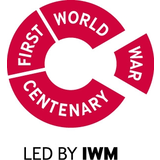Auxiliary hospitals
During the First World War
The organisation of auxiliary hospitals was an important aspect of the Joint War Committee activities during the war.
Role of the British Red Cross
One of the many important services that the Red Cross provided during the First World War was auxiliary hospitals and convalescent homes for wounded servicemen. The Red Cross prepared for this before the conflict even began, finding some suitable properties that could be used as hospitals should war break out. However, they did not anticipate how important this service would be in the recuperation of so many servicemen.
As soon as wounded men began to arrive from abroad the Red Cross’ temporary hospitals were largely available for use, with equipment and staff in place.
Hospital personnel
Auxiliary hospitals were usually staffed by:
- a commandant, who was in charge of the hospital except for the medical and nursing services
- a quartermaster, who was responsible for the receipt, custody and issue of articles in the provision store
- a matron, who directed the work of the nursing staff
- members of the local Voluntary Aid Detachment (VAD), who were trained in first aid and home nursing
In many cases local women from the neighbourhood volunteered in the hospitals part-time, although it was often necessary to supplement voluntary work with some paid roles, such as cooks.
Auxiliary hospitals drew on members who were too old or young for work in a military hospital. Many were unable to leave home for six months due to family commitments, but were willing to sign a three-month hospital contract. Auxiliary hospitals also attracted members who found work in a military hospital too strenuous and others who ‘preferred to be head cook in a small auxiliary hospital to assistant cook in a large military hospital’.
Local members of the medical profession did a large amount of voluntary work in these hospitals. In 1917 the War Office decided that some payment should be given to doctors rendering these services.
Patients
The patients at these hospitals generally did not have life-threatening injuries and needed to convalesce. The servicemen preferred the auxiliary hospitals to the military hospitals as the discipline was not as strict, conditions were less crowded and the surroundings were more homely.
It was partly their popularity and their reputation for an excellent standard of care which lead to many being reopened during the Second World War. They broadened their services to include a range of rehabilitation therapies.
Hospital accommodation
Despite the pre-war preparation, on the outbreak of war both the Joint War Committee and the War Office were inundated with additional offers of buildings for accommodation. It was the Committee’s job to sort through these 5,000 offers to find suitable buildings. The premises were varied and included anything from town halls and elementary schools to large and small
private houses, both in the country and in towns and cities. Those deemed suitable were turned into auxiliary hospitals. These were attached to Central Military Hospitals, which directed the movement of the patients who remained under military control.
Governance and administration
In total there were over 3,000 of these auxiliary hospitals, which were administered under county directors. The War Office fixed and paid grants to hospitals for every patient they looked after, and the grant amount increased annually during the war. At the highest rate, the government paid £1 4s 6d per week, or £63 14s 0d per annum, for each patient. This covered full hospital treatment, food and other costs.
Useful sources of information
Records provide a lot of information about this care for the wounded, the improvised hospitals and the vast number of women who undertook what was for many a completely new type of work. There is, however, no information about the individual patients. The following sources are particularly useful:
- Reports by the Joint War Committee and the Joint War Finance Committee of the British Red Cross Society and the Order of St John of Jerusalem in England on voluntary aid rendered
- to the sick and wounded at home and abroad and to British prisoners of war 1914–1919, (HMSO, London, 1921). This volume contains a chapter outlining the work of the auxiliary hospitals and a roll of hospitals by county in the appendices
- List of the various Hospitals Treating Military Cases in the United Kingdom, (HMSO, London, 1917). Entries are arranged under the different Military Command areas of the country and give the location and size of each establishment. Auxiliary hospitals are included, together with military and civil hospitals. The affiliation between central and auxiliary hospitals is shown on this list.
- Accounts of the work of some hospitals were published at the time in the annual reports of county branches of the British Red Cross.
- Reports covering the work undertaken were compiled and produced at the end of the war by the following counties: Berkshire; Cambridgeshire; Cumberland and Westmorland; Devon; Gloucestershire; North East and East Lancashire; Glamorgan; Hampshire; Kent; London; Monmouthshire; Norfolk; Shropshire; Sussex; East of Scotland. They give descriptions of the work of the local hospitals, often with photographs of the buildings and some contain lists of the VAD staff.
- The County Branches: their organization and work during the first months of the war, Volume I. This book contains brief accounts of the early work of auxiliary hospitals in Bedfordshire, Berkshire, Birmingham, Bristol, Buckinghamshire, Cambridgeshire, Cheshire, Cornwall, Derbyshire, Devonshire, Dorset, Durham, Essex and Gloucestershire. Unfortunately the projected second volume of this work did not appear.
External sources:
- Hospital Records Database (Wellcome Trust/National Archives)
This database provides information on the existence and location of the records of UK hospitals. There are currently over 2,800 entries, compiled by the Wellcome Library for the History and Understanding of Medicine. However, British Red Cross hospitals are very sparsely represented, as they were temporary establishments and not part of the existing hospital system. - Some local archive services hold records relating to auxiliary hospitals and convalescent homes. Details of your local heritage service can be found on The National Archives website.
- Many hospitals were set up in large country houses, which are now managed by The National Trust or English Heritage. Where this is the case, relevant records may still be kept at the property itself. Contact the relevant organisation for further information.
- Oliver, Beryl (1966) The British Red Cross in Action; London; Faber and Faber Limited.
You may also be interested in:
Nursing during the First World War
Thousands of women became Red Cross nurse both at home and overseas. Read their fascinating stories.
Women during WW1
Female VADs did a variety of work during the war, from supplying aid to nursing.
Volunteers during WW1
90,000 ordinary men and women volunteered with the Red Cross during WW1 in hospitals, driving ambulances, and more.


